Content is from Kirkbride et al. 2006Kirkbride et al. 2006:
Kirkbride JH, Jr, Gunn CR, and Dallwitz MJ. 2006. Family guide for fruits and seeds, vers. 1.0. Accessed September 2020-January 2022. URL: https://nt.ars-grin.gov/seedsfruits/keys/frsdfam/index.cfm ., without modification.
Updates are forthcoming.
Fruits: Pistil(s) 1; 1-pistillate. Fruit anthocarpanthocarp:
simple or compound and including some tissue of non-ovarian origin (accessory tissue)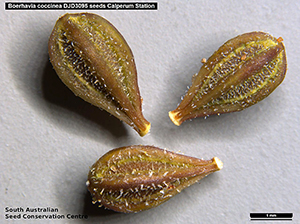 , or pericarpium; simple; samarasamara:
, or pericarpium; simple; samarasamara:
a winged, indehiscent, dry fruit containing a single (rarely two) seed(s)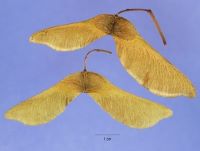 (individual fruits are samarassamara:
(individual fruits are samarassamara:
a winged, indehiscent, dry fruit containing a single (rarely two) seed(s) , but they are within a conelike structure named trymconum); compound, or multiplemultiple:
, but they are within a conelike structure named trymconum); compound, or multiplemultiple:
fruit formed from several flowers clustered in one mass
; trymoconum (Allocasuarina fraseriana (Miq.) L. A. S. Johnson, Spjut Fig. 53A & 2 families Casuarinaceae, Cyclanthaceae); without persistent central column; within accessory organ(s); imbricately arranged with conelike structure & within woodywoody:
texture—consisting mainly of indurate lignified tissues, characteristic of or resembling wood
bracteoles; 1-seeded; 1-seeded; with 1-carpellate; apexapex:
the point farthest from the point of attachment, or the "tip" of an organ not beaked; indehiscentindehiscent:
not beaked; indehiscentindehiscent:
not opening on its own, as in a fruit
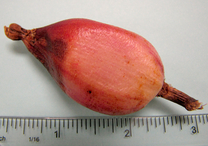 . Epicarpepicarp:
. Epicarpepicarp:
outer layer of fruit wall or pericarp, if divided into layers; note here used synonymously with exocarp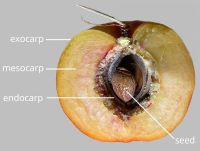 brown (all shades), or black, or gray, or yellow; shinyshiny:
brown (all shades), or black, or gray, or yellow; shinyshiny:
uniformly reflecting a high proportion of incident light at all angles , or dulldull:
, or dulldull:
reflecting only a low proportion of incident light, with no apparent sheen ; durable; without armature; with wing(s); 1-winged; with wing(s) apicalapical:
; durable; without armature; with wing(s); 1-winged; with wing(s) apicalapical:
at or pertaining to the end of the seed or fruit distal from its point of attachment (i.e., base)
; without apicalapical:
at or pertaining to the end of the seed or fruit distal from its point of attachment (i.e., base)
respiratory hole. Mesocarpmesocarp:
the middle layer of the pericarp, if divided into layers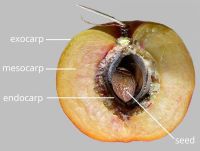 absent. Endocarpendocarp:
absent. Endocarpendocarp:
the inner layer of the pericarp, if divided into layers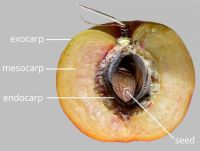 present; not separating from exocarpexocarp:
present; not separating from exocarpexocarp:
outer layer of fruit wall or pericarp, if divided into layers; note here used synonymously with epicarp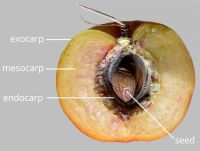 ; thin; not splitting into 1-seeded pyrenes; smooth; without wing; without operculumoperculum:
; thin; not splitting into 1-seeded pyrenes; smooth; without wing; without operculumoperculum:
a dehiscent cap (or lid) of a seed or fruit that opens during germination or dehiscence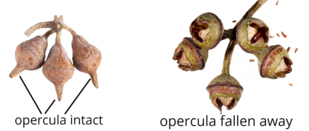 ; without secretory cavities; without mechanism for seedling escape; without grooves; without longitudinallongitudinal:
; without secretory cavities; without mechanism for seedling escape; without grooves; without longitudinallongitudinal:
of or relating to length or the lengthwise dimension
ridges. Funiculusfuniculus:
(alt. funicle) stalk connecting the ovule (later seed) to the ovary (later fruit) placenta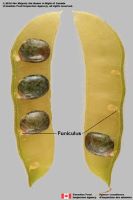 short; short without seed bearing hookswith hooks:
short; short without seed bearing hookswith hooks:
bristles or spines with curved or backwards pointing tips, or with secondary bristles along their length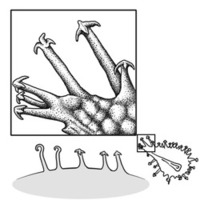 (retinacula); not persisting in fruit after seed shed.
(retinacula); not persisting in fruit after seed shed.
Seeds: Arilaril:
(broad sense) appendicular structure that wholly or partly envelops a seed and is produced from or a modification of the funicle, raphe, or outer integument; usually fleshy or pulpy, sometimes spongy or tufted-capillate, often brightly colored absent. Seed minute; not bowl shaped; not nutlike; without winglike beakbeak:
absent. Seed minute; not bowl shaped; not nutlike; without winglike beakbeak:
a usually firm, terminal appendage, sometimes tapered ; without caudatecaudate:
; without caudatecaudate:
tapering to a long, tail-like appendage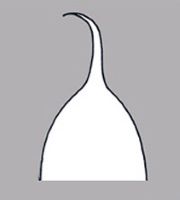 appendage(s); at maturity without food reserves, or with food reserves; with endosperm; without canavanine. Sarcotestasarcotesta:
appendage(s); at maturity without food reserves, or with food reserves; with endosperm; without canavanine. Sarcotestasarcotesta:
pulpy or fleshy outer layer of the seed coat, simulates aril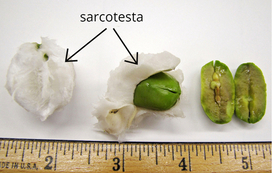 absent. Testatesta:
absent. Testatesta:
seed coat
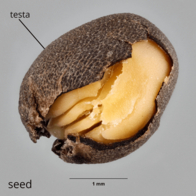 present, or absent; adnate to epicarpepicarp:
present, or absent; adnate to epicarpepicarp:
outer layer of fruit wall or pericarp, if divided into layers; note here used synonymously with exocarp ; without embryo surrounded and capped by viscid tissue; without fleshy or leatheryleathery:
; without embryo surrounded and capped by viscid tissue; without fleshy or leatheryleathery:
texture—moderately thick, tough, and very pliable
layer over hard layer; tight; surface smooth; without crease or line separating cotyledons from hypocotyl-radicle; without notch along margin where cotyledons from hypocotyl-radicle tip approach each other; without glands; without bristles; glabrousglabrous:
without hairs
; without wings; without collar; without operculumoperculum:
a dehiscent cap (or lid) of a seed or fruit that opens during germination or dehiscence ; transparent; monochrome; thin, or membranousmembranous:
; transparent; monochrome; thin, or membranousmembranous:
texture—extremely thin, pliable, and fairly tough
; not becoming mucilaginousmucilaginous:
resembling mucilage; moist and sticky
when wetted; surrounding embryo. Endosperm development nuclear. Embryo differentiated from food reserve; well developed; 1 per seed; completely filling testatesta:
seed coat
 (no food reserve); at one end of seed not extending into a depression or cup; straight; parallel to seed length; with cotyledons abruptly connected to hypocotyl-radicle (nearly); without coleorhiza; without simmondsin; with cotyledons containing oils; without stomata; not green; with 2 or more cotyledons. Cotyledons 2; well developed; 0.28 times length of embryo; 2–3 times wider than hypocotyl-radicle; not concealing hypocotyl-radicle; thick; flat; smooth; with apicesapex:
(no food reserve); at one end of seed not extending into a depression or cup; straight; parallel to seed length; with cotyledons abruptly connected to hypocotyl-radicle (nearly); without coleorhiza; without simmondsin; with cotyledons containing oils; without stomata; not green; with 2 or more cotyledons. Cotyledons 2; well developed; 0.28 times length of embryo; 2–3 times wider than hypocotyl-radicle; not concealing hypocotyl-radicle; thick; flat; smooth; with apicesapex:
the point farthest from the point of attachment, or the "tip" of an organ entire; with margins separate; basally entire; equal in size; not punctatepunctate:
entire; with margins separate; basally entire; equal in size; not punctatepunctate:
surface relief—dotted with pits or with translucent, sunken glands or with colored dots, similar to pitted dotted. Hypocotyl-radicle moderately developed (at best); straight; not thickened.
dotted. Hypocotyl-radicle moderately developed (at best); straight; not thickened.
Noxious weeds: 1 or more USA state noxious weeds in this family.
USA states and territories with listed noxious weeds: Florida (FL).
USA state and territory noxious weeds:
Casuarina spp.: USA state noxious weed: FLª.
Symbols: ªaquatic weed; ●terrestrial weed; °weed in seed.
Last updated February 2006.
Literature specific to this family: Johnson, L.A.S. & K.L. Wilson. 1989. Casurarinaceae: A synopsis. In: P.R. Crane & S. Blackmore, eds., Evolution, Systematics, and Fossil History of the Hamamelidae. Vol 2: 'Higher' Hamamelidae. Systematics Association Special Volume No. 40B, pp. 167–188. Clarendon Press, Oxford.
General references: Corner, E.J.H. 1976. The seeds of Dicots, esp. vol. 2. Cambridge University Press, New York, Cronquist, A. 1981. An integrated system of classification of flowering plants, 1,262 p. Columbia University Press, New York, Goldberg, A. 1986 (dicots) & 1989 (monocots). Classification, evolution, and phylogeny of the familes of Dicotyledons. Smithsonian Contr. Bot. 58 for dicots (314 pp.) & 71 for monocots (74 pp.). [Goldberg's illustrations are reproduced from older publications and these should be consulted], Gunn, C.R., J.H. Wiersema, C.A. Ritchie, & J.H. Kirkbride, Jr. 1992 & amendments. Families and genera of Spermatophytes recognized by the Agricultural Research Service. Techn. Bull. U.S.D.A. 1796:1–500, Schopmeyer, C.S. 1974. Seeds of Woodywoody:
texture—consisting mainly of indurate lignified tissues, characteristic of or resembling wood
plants in the United States. Agric. Handb. 450:1–883, Spjut, R.W. 1994. A systematic treatment of fruit types. Mem. New York Bot. Gard. 70:1–182, and Wood, C.E., Jr. 1974. A student's atlas of flowering plants: Some dicotyledons of eastern North America, 120 pp. Harper & Row, New York.